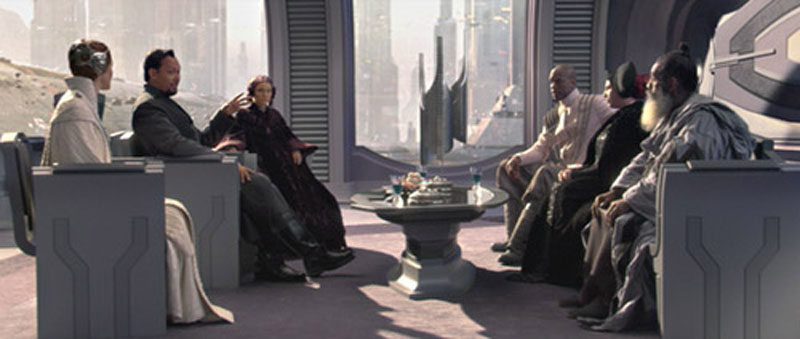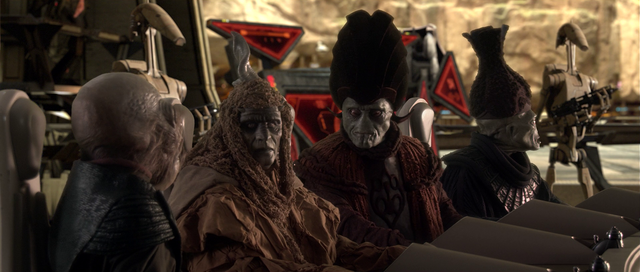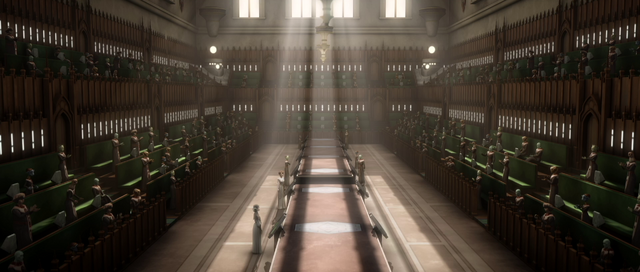
About a week ago, Making Star Wars broke a story that alleged a few things about the premise of Episode VII that many found hard to believe. The assertion that’s attracted the most attention is that the villains will be so-called “Jedi Hunters” (along the lines of the Inquisitor in Star Wars Rebels) who have largely kept Luke Skywalker’s burgeoning Jedi Order on the run in the decades since Return of the Jedi. Plenty has been written about them already, and I’m not about to believe or disbelieve the overall report with anything approaching real confidence, but the larger premise of the rumor did kickstart a pretty interesting discussion that caused me to rethink a lot of my own assumptions about what the galactic status quo “should” be in the Sequel Trilogy.
Last year, in Part II of his A Case For Starting Over series, Alexander Gaultier delved deeply into the Expanded Universe’s handling of the founding of the New Republic, what it did right, what opportunities were missed or mishandled, and so on. But one thing that both fans and detractors of the EU have never really given serious thought to is the notion that thirty years after Palpatine’s death, the Republic wouldn’t really be back just yet.
Longtime Jedi Council forumer Grey1 laid out the ST’s options very astutely by boiling them down to two real choices: you can have an Episode I status quo, wherein the good guys are generally in charge and have to respond to some new threat to their hard-won peace, or an Episode IV status quo, in which our heroes, and the galaxy at large, remain in existential danger.
I have to be honest: us Expanded Universe fans have always taken special delight in turning up our noses at the idea that Endor would really have been the end of the story; that the entire Galactic Empire would just fold like a cheap table without Palpatine around and the galaxy would immediately flip on the “peace” switch and that’d be that.
But to be truly honest? One of the biggest problems with the post-Endor EU is that the bulk of it—and basically the entire resolution of the Rebel/Imperial conflict—was written well before anyone realized just how big of a mess the galaxy was when Palpatine took over. While the earliest sketches of the prequel era made broad mentions of “the disaffected” within the Old Republic, there was no real sense of what the galaxy’s problems were before the Empire, so for the New Republic to fix those problems simply meant “no more Empire”.
Now, of course, we know much, much more.

The galaxy of the Prequel Era is one where corruption and bureaucracy prevented even the well-meaning Chancellor Valorum from doing anything beyond “appointing a commission” to investigate the invasion of a Republic planet. Where countless outer systems needed only the charisma of Dooku to leave the Republic entirely and align themselves with the greedy, venal corporate interests of the Separatist Council. Where loyal Republic citizens, especially in the Core, were slowly coming to conflate “Outer Rim” and “nonhuman” with “anti-Republic”, and where those same citizens were happy to believe that the Jedi were traitors who deserved total annihilation with no due process.
So Palpatine institutes the Empire, and for a while, the Core is thrilled. Security! At last! The outlying systems are less happy, but they’ve been totally ravaged by the war so they’re in no position to do anything about it. Eventually things get bad enough that independent-minded Core senators like Bail Organa and Mon Mothma cross the line into active rebellion. They form a coalition with many of those rimward systems who have been particularly hurt by the Empire, including prominent and ubiquitous alien species like the Mon Calamari, the Bothans, and the Sullustans.
Eventually this coalition makes good and takes Palpatine down. The bulk of the Empire’s forces are still around, and its bureaucracy is still in place, but Palpatine was planning for eternal Sith rule, so without the Sith, everything’s in chaos.
That much is fairly uncontroversial, I’d say—but what happens next?
Well, in the EU, the Alliance gets its shit together and establishes the New Republic relatively quickly. They take Coruscant within a few years, clear out a few crazies, and basically just resume the existing bureaucracy with different people in charge. The books do a bit with corrupt or otherwise ineffectual interests within the senate, primarily the Bothans, but for the most part they’re too busy chasing down the warlord or rogue Jedi of the week—and eventually dealing with an extragalactic invasion—to devote much time to actually improving the galaxy’s status quo beyond “hey, there’s freedom now”. That’s an improvement over the Empire where the outer systems are concerned, but it does nothing to address the problems they had with the Republic in the first place, nor does it address lingering anti-alien or anti-Jedi prejudice, which are serious cultural problems that shouldn’t simply vanish after a couple decades of tyranny.
But in light of the rumors, I’m starting to see a different way forward. I’m seeing a New Republic that starts at the Rim and grows inward, that’s not just supported but run by the real disaffected of the galaxy, instead of just handing the reins right back to the Core. Mon Mothma and Leia Organa are heroes, sure, but their fight was always with Palpatine, not the Old Republic—and you’d never have had the one without the other. Mon and Leia are the Old World of the galaxy, and the Rim is the New World.

Given this altered scenario, then, I think I could be at peace with an unstable galaxy in Episode VII. The Rebels weren’t just fighting a military war, they were fighting to change the way the galaxy worked, and a military victory alone can’t do that; certainly not overnight. A galaxy thirty years after Endor where the New Republic is still being built from the ground up, and looks fundamentally different from what came before, is both plausible and more interesting than an “Episode I scenario”, and it carries the story forward rather than returning it to square one—which would make whatever new conflict the ST chose to introduce feel that much more like it was stapled onto the end of the film saga unnecessarily.
Furthermore, the Rim Republic, as it were, would lay a totally original foundation for the ST’s political backdrop, and give the trilogy a larger story to tell beyond whatever Sith or Dark Jedi business they inevitably cook up. On the one hand, our heroes could still be working to bring former Separatist elements into their fold in the same way the Rebellion in the OT found itself drawing in people like Han and Lando who didn’t especially want to get involved. Bringing in ex-Separatists would both tie the ST into the larger story more directly, and give the cast its much-needed Han Solo analogue in the form of characters who have no reason to trust the Republic any more than they trusted the Empire.
And on the other hand, there’s the Empire themselves. Still clinging desperately to tiny pockets, or even just the Core itself, they’re still around in a form that’s recognizable for casual fans and serious enough to play a role in the new Big Bad’s great scheme, but they’re no longer the ultimate power in the universe—and it shows. And of course, once the new generation of heroes have united their ranks and brought the fight to the enemy, what better way to end Episode IX than with the reconquest of Coruscant once and for all?

Well put, Mike – I’ve been anticipating an EpVII galaxy that is vastly different from what EU readers are used to, and that this “galactic situation” (for lack of a better term) would be one of the greatest departures (and maybe the toughest pill to swallow).
Also, I think the middle part of this essay would serve as a good TL:DR for what is going on in the galaxy during the PT/OT/ST eras over all. It explains why the OT planets are so devastated and run-down, and why the Core worlds embraced Imperial rule. I’ve thought a lot about Star Wars in the last 20 years, and I had never thought about the politics of it that way. Bravo.
I like this idea. It’d also mean that those extra scenes added to the end of ROTJ showing the galaxy (Naboo and Coruscant in particular IIRC) will have to be retconned. It’d also make for some really interesting stories to fill the gap. Unfortunately, that’s also the reason why I think we’re going to be in for Episode I, not IV.
I’ve never interpreted those scenes as being absolute declarations that the Empire was gone from those planets—but then, I’m biased.